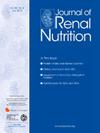Availability of Exercise Program, Perceived Exercise Benefits and Barriers, and Exercise Habits in Maintenance Hemodialysis Patients: A Multicenter Cross-sectional Study
IF 3.2
3区 医学
Q2 NUTRITION & DIETETICS
引用次数: 0
Abstract
Objective
Exercise resources and patients’ perceptions of exercise play a crucial role in influencing exercise participation among maintenance hemodialysis (MHD) patients. However, limited research has explored the availability of exercise programs, patients’ exercise perceptions, and their exercise habits. This study aimed to characterize the availability of exercise programs, patients’ exercise perception, and exercise habits, as well as to examine the associations of these factors in this population.
Methods
This multicenter cross-sectional study surveyed 722 MHD patients from 74 dialysis units across China. A structured questionnaire was used to collect data on sociodemographics, exercise habits, and responses to the Dialysis Patient-Perceived Exercise Benefits and Barriers Scale (DPEBBS) from patients. Additional information about the availability of exercise programs in dialysis units was also gathered. Data were analyzed using independent sample t-tests, linear mixed models, and multiple logistic regression analyses.
Results
Only 23.0% of dialysis units offered exercise programs. Overall, 65.7% of participants reported regular exercise. The availability of exercise programs was significantly associated with higher DPEBBS scores. MHD patients with higher DPEBBS benefits and barriers scores were more likely to exercise regularly. Furthermore, patients from dialysis units with exercise programs demonstrated significantly greater levels of exercise participation compared to those from units without such programs.
Conclusions
Less than one-fourth of dialysis units provide exercise programs for MHD patients, underscoring the need for broader implementation of these programs. Health-care providers and policymakers should prioritize promoting exercise programs, improving patients’ perceptions of exercise, and addressing barriers to increasing exercise participation among MHD patients.
维持性血液透析患者运动计划的可获得性、感知到的运动益处和障碍以及运动习惯:一项多中心横断面研究
目的:运动资源和患者对运动的认知对维持性血液透析(MHD)患者运动参与的影响至关重要。然而,有限的研究探讨了运动计划的可用性,患者的运动感知和他们的运动习惯。本研究旨在描述运动项目的可用性、患者的运动感知和运动习惯,并检查这些因素在该人群中的关联。方法:这项多中心横断面研究调查了来自全国74个透析单位的722例MHD患者。采用结构化问卷收集社会人口统计数据、运动习惯以及患者对透析患者感知运动益处和障碍量表(DPEBBS)的反应。还收集了有关透析单元中运动项目可用性的其他信息。数据分析采用独立样本t检验、线性混合模型和多元逻辑回归分析。结果:只有23.0%的透析单位提供锻炼计划。总体而言,65.7%的参与者报告定期锻炼。运动项目的可获得性与较高的DPEBBS分数显著相关。DPEBBS益处和障碍得分较高的MHD患者更有可能经常锻炼。此外,有锻炼计划的透析病房的患者比没有锻炼计划的透析病房的患者表现出更高的锻炼参与水平。结论:不到四分之一的透析单位为MHD患者提供锻炼计划,强调需要更广泛地实施这些计划。医疗保健提供者和政策制定者应优先推广运动项目,提高患者对运动的认识,并解决MHD患者增加运动参与的障碍。
本文章由计算机程序翻译,如有差异,请以英文原文为准。
求助全文
约1分钟内获得全文
求助全文
来源期刊

Journal of Renal Nutrition
医学-泌尿学与肾脏学
CiteScore
5.70
自引率
12.50%
发文量
146
审稿时长
6.7 weeks
期刊介绍:
The Journal of Renal Nutrition is devoted exclusively to renal nutrition science and renal dietetics. Its content is appropriate for nutritionists, physicians and researchers working in nephrology. Each issue contains a state-of-the-art review, original research, articles on the clinical management and education of patients, a current literature review, and nutritional analysis of food products that have clinical relevance.
 求助内容:
求助内容: 应助结果提醒方式:
应助结果提醒方式:


